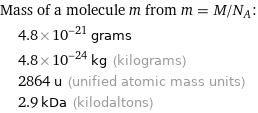Input interpretation

tungstosilicic acid hydrate | molar mass
Result
![Find the molar mass, M, for tungstosilicic acid hydrate: M = sum _iN_im_i Plan: • Write the chemical formula and gather atomic masses from the periodic table. • Determine values for N_i and m_i using these items. • Finally, compute the mass. Write the chemical formula: H_4[Si(W_3O_10)_4]·xH_2O Use the chemical formula to count the number of atoms, N_i, for each element: | N_i H (hydrogen) | 6 O (oxygen) | 39 Si (silicon) | 1 W (tungsten) | 12 Look up the atomic mass, m_i, in g·mol^(-1) for each element in the periodic table: | N_i | m_i/g·mol^(-1) H (hydrogen) | 6 | 1.008 O (oxygen) | 39 | 15.999 Si (silicon) | 1 | 28.085 W (tungsten) | 12 | 183.84 Multiply N_i by m_i to compute the mass for each element. Then sum those values to compute the molar mass, M: Answer: | | | N_i | m_i/g·mol^(-1) | mass/g·mol^(-1) H (hydrogen) | 6 | 1.008 | 6 × 1.008 = 6.048 O (oxygen) | 39 | 15.999 | 39 × 15.999 = 623.961 Si (silicon) | 1 | 28.085 | 1 × 28.085 = 28.085 W (tungsten) | 12 | 183.84 | 12 × 183.84 = 2206.08 M = 6.048 g/mol + 623.961 g/mol + 28.085 g/mol + 2206.08 g/mol = 2864.17 g/mol](../image_source/f26a12695612e4a9d0b9c0282a24cf04.png)
Find the molar mass, M, for tungstosilicic acid hydrate: M = sum _iN_im_i Plan: • Write the chemical formula and gather atomic masses from the periodic table. • Determine values for N_i and m_i using these items. • Finally, compute the mass. Write the chemical formula: H_4[Si(W_3O_10)_4]·xH_2O Use the chemical formula to count the number of atoms, N_i, for each element: | N_i H (hydrogen) | 6 O (oxygen) | 39 Si (silicon) | 1 W (tungsten) | 12 Look up the atomic mass, m_i, in g·mol^(-1) for each element in the periodic table: | N_i | m_i/g·mol^(-1) H (hydrogen) | 6 | 1.008 O (oxygen) | 39 | 15.999 Si (silicon) | 1 | 28.085 W (tungsten) | 12 | 183.84 Multiply N_i by m_i to compute the mass for each element. Then sum those values to compute the molar mass, M: Answer: | | | N_i | m_i/g·mol^(-1) | mass/g·mol^(-1) H (hydrogen) | 6 | 1.008 | 6 × 1.008 = 6.048 O (oxygen) | 39 | 15.999 | 39 × 15.999 = 623.961 Si (silicon) | 1 | 28.085 | 1 × 28.085 = 28.085 W (tungsten) | 12 | 183.84 | 12 × 183.84 = 2206.08 M = 6.048 g/mol + 623.961 g/mol + 28.085 g/mol + 2206.08 g/mol = 2864.17 g/mol
Unit conversion

2.8642 kg/mol (kilograms per mole)
Comparisons

≈ 4 × molar mass of fullerene ( ≈ 721 g/mol )

≈ 15 × molar mass of caffeine ( ≈ 194 g/mol )

≈ 49 × molar mass of sodium chloride ( ≈ 58 g/mol )
Corresponding quantities

Mass of a molecule m from m = M/N_A: | 4.8×10^-21 grams | 4.8×10^-24 kg (kilograms) | 2864 u (unified atomic mass units) | 2.9 kDa (kilodaltons)

Relative molecular mass M_r from M_r = M_u/M: | 2864